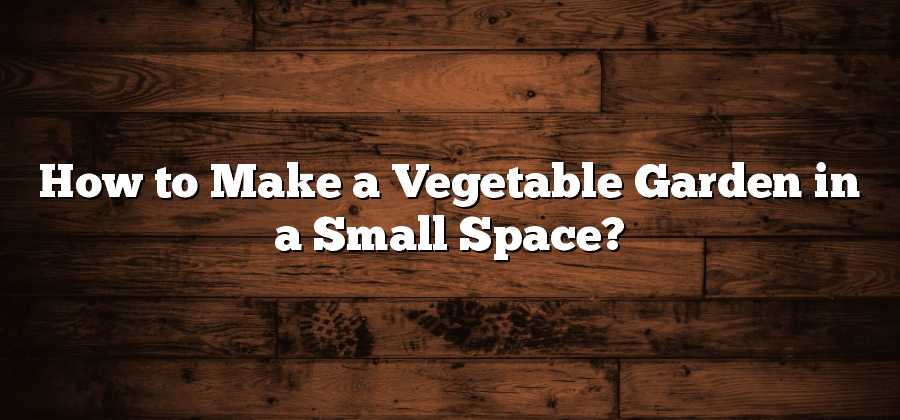Assessing Your Space: Evaluating Your Options
When it comes to growing your own vegetables, one of the first steps is to assess your space and evaluate your options. Consider the available area in your garden or backyard, and determine how much space you have to devote to vegetable gardening. Take into account factors such as sunlight exposure, soil quality, and access to water. Assessing your space will help you make informed decisions about the type and quantity of vegetables you can grow.
In addition to the physical aspects of your space, it is also important to evaluate your own time and commitment. Vegetable gardening requires regular maintenance and care, including watering, weeding, and pest control. Consider your schedule and how much time you can realistically dedicate to your garden. If you have limited time available, opting for low-maintenance vegetables or utilizing time-saving garden techniques, such as container or vertical gardening, may be a suitable choice. Evaluating your options based on your available time will ensure that you can enjoy the fruits (or vegetables) of your labor without feeling overwhelmed.
Selecting the Right Vegetables: Maximizing Yield in Small Gardens
One of the key factors in maximizing yield in small gardens is selecting the right vegetables to grow. When it comes to limited space, it is important to choose vegetables that are well-suited for small-scale gardening. Ideally, you want crops that have compact growth habits, can be easily trained or trellised, and have a short growing season. By selecting vegetables that meet these criteria, you can make the most out of your limited space and ensure a plentiful harvest.
In terms of compact growth habits, focus on crops that do not require a lot of room to spread out. This includes vegetables like lettuce, spinach, and radishes that grow in a compact, upright manner. Additionally, consider crops that can be trained or trellised, such as tomatoes, cucumbers, and peas. By providing support structures, you can effectively utilize vertical space and maximize your garden’s productivity. Lastly, choose vegetables that have a shorter growing season, as this allows you to have multiple harvests throughout the year. Options like beans, beets, and certain varieties of carrots are known for their relatively quick maturation, making them ideal choices for small gardens.
Preparing the Soil: Creating a Nutrient-rich Foundation
Once you have assessed your space and selected the right vegetables for your small garden, it is time to prepare the soil. Creating a nutrient-rich foundation is crucial for the healthy growth and development of your plants.
The first step in preparing the soil is to remove any weeds or grass from the garden area. This can be done by hand or with the help of a garden hoe. It is important to eliminate any competing plants that might hinder the growth of your vegetables. Once the area is clear, it is time to amend the soil. Adding organic matter such as compost or well-rotted manure will provide essential nutrients to the soil and improve its structure. This will create a favorable environment for your vegetables to thrive. Remember to mix the organic matter well into the soil to ensure uniform distribution of nutrients.
Container Gardening: Growing Vegetables in Pots and Planters
Container gardening is an ideal option for individuals with limited outdoor space or those who want to add greenery to their patios, balconies, or even windowsills. By utilizing pots and planters, you can grow a variety of vegetables and herbs in a small area. This method allows you to have complete control over the soil, water, and sunlight requirements of each plant, ensuring optimal growing conditions.
One of the major advantages of container gardening is the ability to maximize your yield. With careful planning and strategic planting, you can grow a significant amount of vegetables in a small space. By selecting compact varieties or dwarf varieties specifically bred for container gardening, you can maximize the number of plants you can grow in each pot or planter. Additionally, you can utilize vertical space by incorporating trellises or hanging baskets to grow vining vegetables such as tomatoes or cucumbers. This not only makes your garden more visually appealing but also increases the overall yield of your container garden.
Vertical Gardening: Utilizing Wall Space for Planting
Vertical gardening is a practical and innovative method for utilizing wall space to grow plants. With limited space available in urban areas and small gardens, this technique offers a solution to maximize productivity. By growing plants vertically, gardeners can make the most of their available space, whether it be a small balcony, patio, or even a wall inside the house.
One of the key benefits of vertical gardening is its versatility. It allows gardeners to grow a wide variety of plants, including vegetables, herbs, flowers, and even certain fruits. From leafy greens such as lettuce and spinach to vining plants like tomatoes and cucumbers, the options are abundant. This technique also offers the opportunity to create visually appealing living walls, adding a touch of natural beauty to any space. Whether it’s a small vertical garden filled with vibrant blooms or a wall covered in cascading vines, vertical gardening is an excellent way to create a green oasis in even the smallest of areas.






